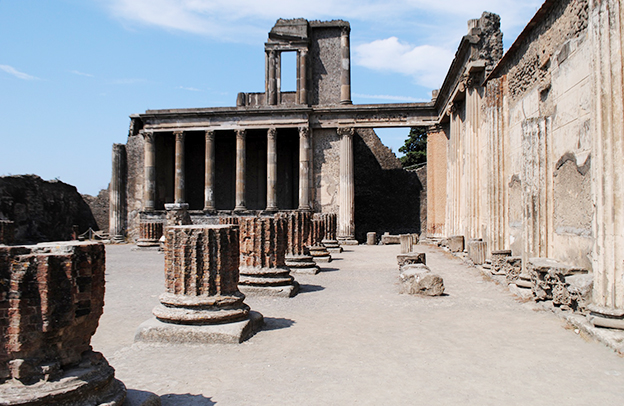7 Places to visit in Pompei, Italy

Are you looking forward to visiting Pompei, Italy but don’t know where to start? Keep reading! Pompei or Pompeii is a city and commune in the Metropolitan City of Naples, Italy. The home of the ancient Roman ruins of Pompeii which are currently part of the UNESCO World Heritage Sites. Get our free Travel Checklist.
Pompeii was first mentioned in history in 310 BCE. In the time of the Second Samnite War.
You might have heard it and its drastic destruction in 79 CE by a nearby volcano.
Also, it wasn’t the only tragedy in Pompeii’s history, the city was hit by a damaging earthquake in 62 CE. It didn’t just affect Pompeii, but Herculaneum as well.
Yet, without the tragic history, we might never have known about the residents of the ancient Pompeii’s stories.
The burial of the city had kept it preserved until its discovery in the late 16th century.
Four centuries later, the site excavations and the volcanological studies have brought out further details.
Thus Pompeii remained buried under layers of pumice stones and ash around 20 feet deep. The city’s sudden burial served to protect it for the next 17 centuries from vandalism, looting, and the destructive effects of climate and weather.
Now, here are the 7 places to visit in Pompei, Italy, especially if you are a begininer traveler.
Visit Foro de Pompeya
The Pompeii forum is a Roman-era forum. It was buried by the eruption of Vesuvius in 79 AD and rediscovered after archaeological excavations in ancient Pompeii.
The area was the main square of the city and represented the political, economic, and religious center in which public events, commercial contracts, and debates used to happen.
It is one of the best-preserved forums of ancient the Italian peninsula.
It is bounded by some of the most important buildings in the city, such as the public administration building, the Macellum basilica, the mensa Ponderaria, the temples of Apollo, Jupiter, and Vespasian, the temple of the Public Lares, and the Eumaquia building.
The original forum was flanked by large arches and paved with travertine marble.
It was presided over by the temple dedicated to Jupiter, Juno, and Minerva. A colossal head of the father of the gods was found in the cella or inner room of the temple, which is accessed by a staircase.
Visit Santuario de la Virgen del Rosario de Pompeya
The Pontifical Shrine of the Blessed Virgin of the Rosary of Pompei is a Roman Catholic cathedral.
Bartolo Longo started restoring a church in the late 19th century and promoted a festival in honor of Our Lady of the Rosary.
Two years later, Longo obtained a painting of Our Lady of the Rosary from a convent in Naples and raised funds to restore the image in order to locate it in the church.
It depicts the Virgin Mary and Child Jesus, presenting rosaries to Saint Dominic and Saint Catherine of Siena.
He was encouraged by Giuseppe Formisano, Bishop of Nola, to begin the construction of a larger church. The church was consecrated in 1891.
The façade of the sanctuary culminates with the statue of the Virgin of the Rosary, a work of Gaetano Chiaromonte. It was carved from a single block of Carrara marble.
You might consider visiting the shrine in May or October, to join the solemn prayers of petition.
Visit the Temple of Giove
The Temple of Giove or Jupiter was a temple in the Roman Pompeii, combined by its forum.
Initially, it was dedicated to Jupiter alone, before becoming the temple of the Capitoline Triad.
It was built in the second century BC, at the same time as the temple of Apollo was being renovated.
Here is where the Roman influence over Pompeii increased. Just like that, the Roman Jupiter superseded the Greek Apollo as the town’s highest god.
Jupiter was the ruler of the gods and the protector of Rome, where his temple was the center of the Roman religion and the cult of the state.
In the basement of the temple, there were sacred objects, gifts left by believers, so a public treasure called the Aerarium.
The temple of Jupiter is considered one of the most beautiful European monuments.
Rectangular in its floor plan and the temple served to celebrate Jupiter’s cult. Lying on an elevated podium, with a six-column porch in front of it. And embossed images on the portal.
Visit the Temple of Venus
The most important roman deity in Pompeii was Venus, the goddess of love and beauty.
Pompeii people dedicated the temple to their powerful goddess, building it on a terrace overlooking the sea between Porta Marina and the Basilica.
Many buildings that had occupied that area were demolished. Only a few were retained and became lodgings for the temple priests.
Enjoy a Visiting tour of Pompeii’s Basilica
Basilica in the Roman Catholic and Greek Orthodox churches is a canonical title of honor given to church buildings that are distinguished either by their antiquity or by their role as international centers of worship because of their association with a major saint, or an important historical event.
But in Ancient Roman architecture, a basilica is a large public building with multiple functions, typically built alongside the town’s forum.
The Basilica of Pompeii was one of the most successful building types of roman architecture which evolved into Christian architecture.
The building dates back to the second century, and it’s known for its columns.
Make sure to visit Teatro Piccolo
The theatre area of Pompeii is located in the southwest region of the city.
Three main buildings make up this area: the Large Theatre, the Odeon, and the Quadriporticum. These served as an entertainment and meeting center of the city.
Pompeii had two stone theatres of its own nearly two decades before the first permanent stone theatre was erected in Rome.
The Large Theatre was built into a natural hill in the second century BC and was one of the first permanent stone theatres in the Roman empire.
In the Greek style, the tiered seating extends from the orchestra carved out of the hillside. The Roman influence is seen above this gallery where four tiers rested upon an arched corridor.
The caved audience seating area was divided into three sections: the lowermost section was reserved for senators, magistrates, and other noble people. The middle section, the media, sat the middle class. The top, the summa, was reserved for the plebeians.
Visit Granaries of the Forum
Today, the forum is the greatest archaeological inventory of the city. It has more than 9000 artifacts from the excavations in Pompeii and its territory.
It preserves the terracotta crockery that was used in the last decades of the life of the city for everyday activities.
You will find their pots, pans for cooking, bottles, amphorae, large containers used to transport oil, wine, and fish sauce throughout the Mediterranean.
The exhibited items also include marble tables and baths for fountains that adorned the entrances of houses.
Some casts of victims of the eruption as well as that of a dog and a tree.
The building was built after the earthquake of 62 AD and it might have not been completed at the time of the eruption.
Concluding note on the 7 Places to visit in Pompei, Italy
Pompeii is all about history, tragedy, archaic monuments that were left from the Roman Times.
If you want to capture the essence of Pompei majesty, you might start with the places mentioned above, but don’t limit yourself to them if you got the time. You can hire a guide or you can follow the instructions on the map and your curiosity.
Don’t forget your comfortable shoes and sunscreen. Keep traveling and enjoy learning about history.
If you find any value in this post, share also with your friends who might need it. Get our Free Travel Checklist for your next trip.






